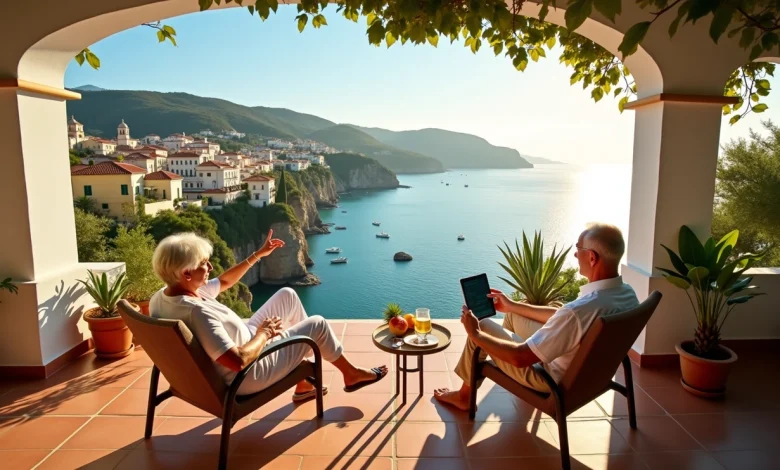
12 Best Countries for US Retirees: Complete Cost Guide for 2025
More Americans than ever are choosing to retire abroad. Right now, 712,000 Americans living overseas get Social Security benefits—a dramatic 21% jump over the last twelve years. This trend shows how retirement plans have seen a major change.
The numbers tell an interesting story. Almost one in five Americans close to retirement would think about moving to another country. This makes sense since almost half of US families don’t have any retirement savings. The situation looks even more challenging as more than 17 million Americans aged 65 or older—about one in three—struggle financially. Many retirees look into international options that offer better financial security and improved quality of life.
Panama tops the list as the world’s best retirement spot for 2025, according to International Living’s Annual Global Retirement Index. This detailed ranking comes from first-hand accounts of people who live in these retirement havens. American retirees can find great tax benefits in several countries, ranging from full foreign income exemptions to tax rates as low as 7%.
This piece breaks down the 12 best countries for US retirees in 2025. It focuses on living costs, healthcare choices, visa rules, and lifestyle options. You’ll find everything needed to guide your retirement abroad, whether you want tax benefits, affordable healthcare, or a fresh start in a new place.
Portugal
Image Source: Terratern
Portugal is Western Europe’s most affordable retirement destination. American retirees find an appealing mix of Mediterranean climate and historic charm here. The cost savings compared to life in the US are remarkable.
Cost of Living in Portugal
A retired couple needs just $2,500 to $3,000 monthly to live well outside major Portuguese cities. Housing takes the biggest chunk of expenses. You can rent furnished one-bedroom apartments in city centers for under $1,000 per month. The country’s interior offers even better deals with charming two-bedroom homes starting at $450 monthly. Food costs much less than in the US. Local produce, fresh seafood, and quality wines sell at a fraction of American prices. A couple’s utility bills usually run between $130-$140 each month. High-speed internet and cell phone packages add another $50-$75. Americans can expect their money to go twice as far in Portugal.
Healthcare in Portugal
Portugal ranks 23rd globally in Numbeo’s 2025 Health Care Index. The quality is exceptional and prices are affordable. The public healthcare system (Serviço Nacional de Saúde or SNS) covers all residents. New arrivals need private insurance at first. Private healthcare won’t break the bank. Simple plans start around $30 monthly for couples in their 40s and rise to about $300 for those in their 60s. English-speaking medical professionals are easy to find in private facilities. Prescription costs are a big deal as they’re much lower than US prices. Medications like insulin that cost $1,000 monthly in the US are available for minimal amounts here.
Visa Options for Portugal
The D7 visa is the main path for American retirees. This retirement or passive income visa requires applicants to show monthly passive income of at least €760 (about $840) or savings of €9,120 ($10,080). You’ll also need proof of accommodation and health insurance. Living in Portugal for over 183 days yearly is mandatory. The path to permanent residency or citizenship opens up after five years.
Lifestyle and Culture in Portugal
Portuguese hospitality makes foreigners feel at home quickly. English is common in popular expat areas like the Algarve, Silver Coast, and Lisbon suburbs. Learning simple Portuguese helps with daily life and integration. Life moves at a slower pace than America – a change most retirees find refreshing. Making friends is easy through expat groups and social activities.
Taxation in Portugal
The tax landscape has changed recently. The Non-Habitual Resident (NHR) program’s 2023 update, “NHR 2.0,” now favors those in research, startups, or innovative fields. Regular tax rates for residents range from 13.25% to 48% based on income. A tax treaty between Portugal and the US prevents double taxation. Social Security benefits go further here. The average annual benefit for 65-year-old Americans ($30,708) is more than Portugal’s average yearly income.
Panama
Image Source: Prime Solutions Tax & Legal
Panama ranks among the top five retirement destinations worldwide and often takes the number one spot in International Living’s Annual Global Retirement Index.
Cost of Living in Panama
Panama isn’t the cheapest option in Central America anymore, but living costs are nowhere near U.S. prices—about 36.3% lower overall. Retired couples can live well on $1,500 to $3,000 monthly with rent included. Single retirees need just $1,000 to $1,200 in certain areas. Housing takes the biggest chunk of your budget. Panama City’s apartments cost between $800 and $1,500 monthly, though you can find rentals for $500 or less in other regions. Utilities won’t break the bank. Water bills rarely exceed $20 monthly, and cell phone plans start at $5 for hundreds of minutes.
Healthcare in Panama
Panama’s healthcare quality matches many developed nations but costs much less. The country has both public and private systems, and most expats choose private facilities. Doctors often train abroad and speak English. Private health insurance costs range from $50 to $300 monthly based on age and coverage. Doctor visits are affordable even without insurance—$2 at public facilities or $20 at private clinics. Panama City’s Hospital Punta Pacifica partners with Johns Hopkins Medicine International, which ensures top-quality care.
Visa Options for Panama
The Pensionado visa gives American retirees the best deal. You’ll need proof of lifetime monthly pension income of $1,000 ($750 if you buy property worth $100,000+) plus $250 for each dependent, a clean criminal record, and a simple medical exam. The process takes 3-6 months. This visa lets you become a permanent resident right away, and you only need to visit once every two years.
Lifestyle and Culture in Panama
Panama offers something for everyone. You can choose between city life in Panama City, beach living in Coronado, mountain views in Boquete, or island vibes in Bocas del Toro. The U.S. dollar serves as currency, so there’s no math needed for exchange rates. Miami is just 2 hours and 50 minutes away by direct flight, making U.S. trips easy. Life moves at a slower pace here than in many South American countries, and family comes first. You’ll find welcoming expat communities in Boquete, Pedasí, and Panama City.
Mexico
Image Source: Bright!Tax
Mexico is home to more than 1.6 million US citizens. This makes it a perfect retirement spot for Americans who want affordable living while staying close to their family and friends.
Cost of Living in Mexico
A couple can retire comfortably in Mexico on $2,000 to $3,000 per month. Some areas are even cheaper – you can live well on just $1,500. Housing costs vary greatly between regions. Coastal areas and tourist spots cost more than inland cities. Take Guanajuato City for example – you can buy a two-bedroom home for under $150,000, while rent ranges from $600 to $1,400 monthly. Property taxes are surprisingly low and rarely cost more than $400 a year.
Healthcare in Mexico
Mexico’s healthcare system stands out with both public and private options for expats. The country has become a hotspot for medical tourism, drawing 3 million international patients each year. Healthcare costs here are half of what you’d pay in the United States.
You can access public healthcare through two main programs:
- IMSS (Instituto Mexicano del Seguro Social): Legal residents can join this program. Monthly costs depend on age – about $63 for ages 50-59, going up to $93 for those 70-79
- INSABI: This program offers free healthcare for people with pre-existing conditions or those who can’t afford IMSS
Most expats prefer private healthcare. The savings are impressive – a cardiac bypass surgery costs around $27,000 in Mexico compared to $144,000 in the US. Dental work is also much cheaper. Dental implants cost about $1,650, while you’d pay over $4,000 in America.
Visa Options for Mexico
Retirees can choose between temporary and permanent resident visas. A temporary visa needs proof of $4,185 monthly income or $69,750 in savings. Permanent residency requires $7,300 monthly income or $300,000 in savings. The process starts at a Mexican consulate in your home country and usually takes 10-15 working days.
Safety and Expat Communities in Mexico
While some areas need caution, many places are safe for expats. Mérida, San Miguel de Allende, and Puerto Vallarta rank among the safest cities in Mexico. These areas have thriving expat communities that provide great social networks and support. The Lake Chapala region has the world’s largest concentration of US expats, with plenty of cultural and fun activities to enjoy.
Spain
Image Source: CityBit Happiness Holidays
Spain ranks fourth best worldwide for expats according to Expat Insider. American retirees love it here because of its amazing quality of life, European charm, and easy access to other countries.
Cost of Living in Spain
Life in Spain costs much less than in the United States – about 38.3% lower for both consumer prices and rent. Your monthly budget depends on where you live. Barcelona, a popular choice, needs around $2,500 for basic living or $4,000+ for a more comfortable lifestyle. Housing takes the biggest chunk of your budget. A one-bedroom apartment in city centers costs about $1,005 monthly, while similar places outside cost around $750. You’ll spend about $139 on utilities each month, and public transport passes are just $35. Most retirees live well on $25,000 yearly – that’s just over $2,000 per month.
Healthcare in Spain
Spain’s healthcare system ranks 26th globally in the 2025 Health Care Index, way ahead of the United States at 69th place. The public healthcare system (Sistema Nacional de Salud – SNS) covers all eligible residents. New visa holders need private health insurance at first. Monthly premiums range from $50-$300 based on age and coverage. These costs beat U.S. prices by a long shot, with most plans running between $112-$224 monthly. The public healthcare system becomes available after living here for five years.
Visa Options for Spain
The Non-Lucrative Visa works best for American retirees. You’ll need to show monthly income of $2,588 or yearly income of $31,050. Each extra family member requires another $647 monthly or $7,763 yearly. The visa starts with one year and you can renew it twice for two years each time. After five years, you can apply for permanent residency. You’ll also need private health insurance, a clean criminal record, and medical certification.
Cultural Benefits of Retiring in Spain
Spain offers a vibrant Mediterranean lifestyle with great weather year-round that lets you enjoy the outdoors. Many retirees feel healthier just from walking daily and eating the Mediterranean way. The food here is amazing – fresh seafood, lots of produce, and some of the world’s best wines. You won’t need a car because public transportation works great and cities are perfect for walking. Spain leads in social progress too – they legalized same-sex marriage in 2005, ten years before the U.S..
Malaysia
Image Source: PropertyGenie
Malaysia welcomes American retirees with open arms. This Southeast Asian gem combines rich cultural diversity with affordable retirement options in a tropical paradise.
Cost of Living in Malaysia
Living costs in Malaysia are 53.6% lower than the United States, not counting rent. Housing costs will surprise you – a one-bedroom apartment in downtown Kuala Lumpur costs just $373 per month. The prices drop even further outside the city center to about $261. Penang Island, where many expats live, lets you enjoy a comfortable life for $2,500 monthly. This budget gets you a three-bedroom condo with ocean views. A single person can live well on $1,500 monthly.
Healthcare in Malaysia
The country stands at 34th place globally for healthcare quality. Medical tourism thrives here with over 1 million foreigners seeking treatment each year. The healthcare system works on two levels – public and private. Most expats choose private facilities. Medical care won’t break the bank – doctor visits cost between $15-$65. Private hospital stays run about $200 per night, while medications cost just a third of US prices. Most doctors trained in the UK, US, or Australia, so you’ll find quality care and English-speaking medical staff everywhere.
Visa Options for Malaysia
The Malaysia My Second Home (MM2H) program serves as the main path for American retirees. You’ll get a five-year renewable visa. Current rules need you to keep RM1,000,000 ($223,065) in a Malaysian bank and show monthly offshore income of RM40,000 ($8,922). Another choice is the Premium Visa Program (PVIP), launched in 2022. It asks for similar financial proof plus RM200,000 in government fees for the main applicant.
English Proficiency and Expat Life in Malaysia
English works as a second language across Malaysia, especially among professionals. This easy communication explains why 250,000 foreign expats call Malaysia home. Penang Island draws many retirees because of its cultural richness and beautiful coastline. The country’s strong infrastructure, stable political climate, and friendly locals make it a top choice for expatriates.
Greece
Image Source: Get Golden Visa
Greece, the birthplace of Western civilization, welcomes American retirees with its Mediterranean charm, rich history, and affordable lifestyle along pristine coastlines and beautiful islands.
Cost of Living in Greece
Living expenses in Greece are 26% lower than the United States. A single retiree needs about USD 1,000 monthly to live comfortably, while couples should budget USD 1,500-2,000 including rent. Housing costs vary by location. A furnished two-bedroom apartment in Athens costs USD 1,200 monthly. Similar apartments in coastal Chania or historic Nafplio are more affordable at USD 860. Property buyers can expect to pay USD 295,000 in Athens, USD 250,000 in Chania, and USD 160,000 in Nafplio. Basic utilities average USD 45 monthly, water bills run USD 32, and communication costs remain reasonable with mobile plans at USD 21.50 and internet/cable packages at USD 45.
Healthcare in Greece
The Greek healthcare system ranks among the world’s top 15. Greeks enjoy some of the EU’s highest life expectancies—79 years for men and 84 for women. The system combines public services (ESY) with private options. Expats can access public healthcare through Social Insurance Institute (IKA) contributions. EU citizens can use their European Health Insurance Card for temporary coverage. Many expatriates choose private healthcare because it offers shorter wait times and English-speaking staff. Private insurance costs between €30-€250 monthly based on age and coverage. Medical expenses are modest compared to American prices: doctor visits cost USD 38, specialist consultations USD 54, and dental cleanings USD 43.
Visa Options for Greece
The Financially Independent Person (FIP) visa suits non-EU retirees best. This visa needs proof of monthly income of at least €2,000 (USD 2,150) or savings between €24,000-€84,000 (USD 25,800-90,300) in a Greek bank account. The Golden Visa program provides another path with five-year renewable residency through a minimum real estate investment of €250,000 (USD 268,000). This visa can lead to citizenship after seven years. Both options require complete medical insurance from a Greek provider.
Taxation in Greece
People who stay 183+ days yearly must pay tax on worldwide income at rates from 9% to 44%. Greek tax laws favor retirees with a flat 7% tax rate on all foreign-source income for 15 years. High net-worth individuals can benefit from the Non-Dom Regime with a €500,000 minimum investment. This regime requires a flat €100,000 annual tax regardless of foreign income. The US-Greece tax treaty protects against double taxation. These tax benefits make Greece an attractive destination for American retirees looking to optimize their retirement finances.
Thailand
Image Source: ThaiEmbassy.com
Thailand stands out as an exceptional value among Southeast Asian retirement destinations. The country’s tropical climate and warm hospitality continue to attract retirees from around the world.
Cost of Living in Thailand
American retirees can enjoy a comfortable life in Thailand for $1,500-$2,000 per month. Location significantly impacts housing costs. A one-bedroom apartment in Bangkok typically costs $650 monthly, while similar homes in Chiang Mai go for just $330. Those seeking luxury can find beautiful beachfront villas in Phuket or Koh Samui at around $2,200 per month. Monthly utility costs range from $75-$300 based on usage.
Healthcare in Thailand
Thailand’s healthcare system ranks among the world’s top five countries with JCI-accredited facilities. The country offers both public and private healthcare options. Private facilities feature Western-trained doctors who speak English fluently. Private hospital consultations start at $16, and physiotherapy sessions cost just $17.80. Many expatriates choose private insurance plans that start at $400 per year.
Visa Options for Thailand
Americans over 50 can apply for the Non-Immigrant O-A (Long Stay) visa as their main retirement option. Applicants must show either $2,000 in monthly income or maintain a $25,000 deposit in a Thai bank for two months. The Thailand Elite Visa presents another option with 5-20 year memberships that include exclusive benefits.
Lifestyle and Culture in Thailand
Retirees can choose between bustling Bangkok and peaceful beach communities. The country’s rich culinary heritage is accessible through street food that costs just $3 per meal, making daily life both enjoyable and affordable.
France
Image Source: FrenchEntrée
France attracts American retirees with its rich culture, amazing quality of life, world-class healthcare and delicious food traditions.
Cost of Living in France
A retired couple needs $2,225 to $2,625 monthly to live comfortably in a modest apartment or townhouse. Location plays a big role in housing costs. A one-bedroom apartment in Paris costs €1,392 ($1,520), while Strasbourg’s prices drop to €795 ($872). Pau offers even better deals at €579 ($635). Housing prices are 34% cheaper than the US, and property taxes are just one-tenth of American rates. French food is a bargain too. You can enjoy a three-course gourmet lunch for €28 ($31), and bistro meals cost about €14 ($15.30).
Healthcare in France
France’s healthcare system ranks among the world’s best. The public system (Sécurité Sociale) becomes available to retirees after three months of living there. Medical costs are much lower than American prices, with the system covering 70-80% of expenses. Doctor visits cost €25 ($27) and specialist appointments are €50 ($55). Private insurance starts at €35 ($38) monthly and covers the remaining costs. Hospital stays get 80% coverage in the first month and full coverage after that.
Visa Options for France
Anyone staying beyond 90 days needs a long-stay visa. You must show financial resources that match or exceed France’s minimum wage (SMIC)—currently €17,116 ($18,590) yearly. The required papers include a valid passport, pension certificate, a promise not to work, proof of where you’ll live, and travel health insurance covering at least €30,000. Visa processing usually takes about 15 days.
Taxation in France
French residents pay taxes on their worldwide income at rates from 0% to 45%. High-income earners face extra charges. Singles pay 3% more on income over €250,000 (€500,000 for couples) and 4% more on income over €500,000 (€1,000,000 for couples). The US-France tax treaty protects against double taxation, and US pensions get taxed only in the United States.
Italy
Image Source: The Italian Lawyer
American retirees love Italy’s rich history, art-filled cities, and exceptional food culture. This beautiful country stands out as a top European retirement destination.
Cost of Living in Italy
Living expenses in Italy are 32% lower than the United States. A retired couple needs about $3,425 monthly to live comfortably outside major cities. The northern regions cost more than the south. Small towns offer one-bedroom apartments for around $500 monthly, while Milan’s fashion districts demand premium prices. Property taxes are surprisingly low. Renters insurance rarely costs more than $341 per year.
Healthcare in Italy
Bloomberg ranks Italy’s healthcare system among the world’s best. The public system (Servizio Sanitario Nazionale) gives residents complete coverage. Private health insurance ranges from €100-€500 ($108-$540) monthly based on age. English-speaking doctors are common in private facilities. Many healthcare professionals have trained in Western countries.
Visa Options for Italy
Retirees need the Elective Residence Visa which requires passive income of €31,160 ($34,536) yearly. The process usually takes 2-4 months. Permanent residency becomes available after five years, and citizenship after ten years.
Cultural Life in Italy
Rome and Florence are just the beginning. Life in Italy ranges from Sicily’s coastal charm to peaceful Tuscan countryside retreats. Many expats report better health as they walk more and enjoy the Mediterranean diet.
Costa Rica

Image Source: Grupo Gap
Costa Rica, often called “the Switzerland of Central America,” draws American retirees with its excellent healthcare system and laid-back philosophy that shapes its national motto.
Cost of Living in Costa Rica
A single person needs USD 1,600-2,000 monthly to live comfortably. Retired couples can enjoy a good lifestyle with USD 2,000-3,000. Housing takes the biggest chunk of expenses. A furnished two-bedroom apartment costs between USD 600-1,400 monthly. The utility bills stay reasonable. Electricity runs from USD 30-500, depending on how much you use air conditioning. Local markets help save money significantly. You can buy pineapples for USD 1.50 and lettuce for just 50 cents.
Healthcare in Costa Rica
The World Health Organization ranks Costa Rica’s healthcare system 36th globally, which puts it ahead of the United States. The mandatory CAJA system provides residents complete coverage. Members pay just 7-11% of their reported income for all procedures, appointments, and prescriptions. Private healthcare adds flexibility to your options. Doctor visits cost USD 60-75, and specialist consultations run about USD 100.
Visa Options for Costa Rica
The country offers three main paths:
- Pensionado: You need USD 1,000 monthly pension income
- Rentista: You must deposit USD 60,000 that generates USD 2,500 monthly for two years
- Inversionista: You need to invest USD 150,000 in Costa Rica
Pura Vida Lifestyle in Costa Rica
The phrase “pura vida” captures Costa Rica’s essence of optimism and relaxation. This cultural mindset teaches people to be grateful and mindful while appreciating life’s simple moments. The country shows its balanced living approach through environmental protection. It houses 5% of Earth’s biodiversity in an area smaller than one-third of Florida.
Ghana
Image Source: TheAfricanDream.net
Ghana has emerged as a popular destination where African Americans reconnect with their ancestral roots. The country offers simple living costs and welcomes newcomers into its community.
Cost of Living in Ghana
Living expenses in Ghana cost nowhere near what you’d pay in the United States. An expat-quality apartment in Accra ranges from $700-$1,200 per month. This compares well to mid-sized American cities where similar housing costs $1,500-$2,500. Local food stays cheap, though American brands come at premium prices. Transportation costs $20-$40 monthly, while Americans typically spend $70-$120 back home.
Healthcare in Ghana
Ghana’s healthcare works through two systems. The National Health Insurance Scheme covers simple care at government facilities. Most expatriates choose private hospitals that provide better standards and shorter wait times. Quality medical care varies a lot outside major cities, so international health insurance remains crucial.
Visa and Citizenship Options in Ghana
The path to permanent residency offers two main routes. You can get an Indefinite Residence Permit after living there continuously for 12 months plus five accumulated years. The Right of Abode program serves people of African descent from the diaspora specifically.
Why African Americans Are Moving to Ghana
Ghana’s “Year of Return” campaign has drawn at least 1,500 African Americans since 2019. A landmark ceremony in 2024 welcomed 524 new Ghanaian citizens. Many new residents point to America’s racism as their reason for leaving. They’ve found a sense of peace and belonging in Ghana that America never provided.
Dominican Republic

Image Source: Migración
The Dominican Republic beckons US retirees with endless sunshine and living costs that are nowhere near what you’d pay stateside.
Cost of Living in Dominican Republic
Life here lets retirees stretch their budget twice as far compared to warm US cities like Miami or Phoenix. Monthly rent for a two-bedroom home ranges from $400 to $800, depending on where you settle. Property hunters can find homes starting at $70,000 to $150,000 across many regions. Local grocery shopping saves you around 60% compared to major US cities.
Healthcare in Dominican Republic
Quality medical care is available in Santo Domingo, Santiago, and Punta Cana’s private hospitals where doctors speak English. Medical staff often have Western training credentials. Your annual private insurance might cost between $500 and $1,500, based on your age and coverage needs. A doctor’s visit could set you back just $40 if you pay cash. Medicare coverage doesn’t extend to this Caribbean nation.
Visa Options for Dominican Republic
You’ll need to show proof of $1,500 monthly pension income to qualify for a Pensionado visa. This visa comes with perks like tax breaks on overseas income and reduced rates for utilities and entertainment. The process requires your birth certificate and a clean background check.
Safety and Lifestyle in Dominican Republic
Santo Domingo and other large cities present some safety challenges. Resort areas provide better security, and most expats feel safe in their communities. The local lifestyle means dealing with occasional power cuts and busy city traffic.
Comparison Table
| Country | Monthly Cost of Living (Couple) | Healthcare Ranking/Quality | Visa Requirements | Average Monthly Rent (1-2 BR) | Notable Benefits |
|---|---|---|---|---|---|
| Portugal | $2,500-$3,000 | Ranks 23rd globally | D7 Visa: €760/month income or €9,120 savings | $450-$1,000 | Affordable European lifestyle with great weather |
| Panama | $1,500-$3,000 | Top-tier private facilities | Pensionado: $1,000/month pension | $500-$1,500 | US dollar economy with flexible stay options |
| Mexico | $2,000-$3,000 | Healthcare 50% cheaper than US | Temporary: $4,185/month income | $600-$1,400 | Strong US expat community near home |
| Spain | $2,500-$4,000 | Ranks 26th globally | Non-Lucrative: $2,588/month income | $750-$1,005 | Universal healthcare plus efficient transit systems |
| Malaysia | $1,500-$2,500 | Ranks 34th globally | MM2H: $223,065 deposit + $8,922/month income | $261-$373 | English-friendly with modern amenities |
| Greece | $1,500-$2,000 | Top 15 globally | FIP: €2,000/month income | $860-$1,200 | Low foreign income tax with Mediterranean charm |
| Thailand | $1,500-$2,000 | Top 5 in JCI-accredited facilities | O-A Visa: $2,000/month income or $25,000 deposit | $330-$650 | Budget-friendly with world-class medical care |
| France | $2,225-$2,625 | Among world’s finest | €17,116 annual income | $635-$1,520 | Premium healthcare with rich culture |
| Italy | $3,425 | Among world’s best | €31,160 annual passive income | $500+ | Historic charm with minimal property taxation |
| Costa Rica | $2,000-$3,000 | Ranks 36th globally | Pensionado: $1,000/month pension | $600-$1,400 | Complete CAJA healthcare coverage |
| Ghana | Not specified | Dual system with private options | 12 months continuous residence | $700-$1,200 | African heritage programs with cultural integration |
| Dominican Republic | 50% less than US cities | Quality private facilities | Pensionado: $1,500/month pension | $400-$800 | Foreign income tax benefits |
Americans now see retiring abroad as a practical way to secure their financial future and improve their quality of life. Many countries offer big advantages compared to staying in the United States, especially when you have lower living costs and better healthcare access. Each place brings its own cultural flavor and lifestyle perks, and these international retirement spots share some common benefits.
Money matters drive most retirement choices. Life in Portugal, Panama, and Mexico lets couples live well on $2,000-$3,000 per month—that’s half what you’d spend in the US for the same lifestyle. Healthcare is a big deal as it means that most of these countries rank higher than America on global healthcare scales, with services costing much less than US prices.
Each country’s visa rules are different, but most have simple options for retirees who meet basic income requirements. Thailand’s Non-Immigrant O-A visa, Panama’s Pensionado program, and Portugal’s D7 visa are great ways to get permanent residency for Americans.
Ghana’s story stands out with its growing African American retiree community. This shift goes beyond economics—it’s about cultural connection. Ghana’s Right of Abode program welcomes people of African descent, and many retirees say they’ve found a sense of belonging they never had in the United States.
Tax benefits make these moves even more attractive. Greece keeps things simple with a 7% flat tax on foreign income. Panama doesn’t tax foreign-earned income at all. Smart tax planning helps retirement savings last longer.
Your perfect retirement spot depends on what matters most to you. Some love Portugal’s Mediterranean sunshine, others prefer Italy’s rich culture, or Southeast Asia’s affordable luxury. Before making the move, think about how you’ll handle cultural shifts, language differences, and being far from family. Notwithstanding that, these international spots offer exciting alternatives to typical American retirement—mixing smart money choices with life-changing experiences.





